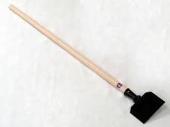
 1
1




The keys to an easy peel are to cut the tree when it is actively growing, which only happens in the spring of the year, and peel it as soon as possible thereafter. In spring, the cambium is dividing rapidly and creating new wood, resulting in a soft, slippery layer beneath the bark. This allows the bark to be peeled away easily. Loggers know to be careful not to bump up against trees at this time of year (generally mud season to mid summer), since just a light bump against the “loose” bark of the season can cause a large section to be stripped completely off.
By the time autumn rolls around, the sapwood and cambium are drier and the bark has tightened. If you try to peel a tree in autumn, you’ll find the bark is practically glued to the wood. The most important part of any log-peeling task, therefore, is planning. https://northernwoodlands.org/articles/article/peeling_logs
 ) Or is this too short for the trees to recover? After this cutting any further cutting ought to be above this? These are mostly Maple, Bradford Pear, and Redbud, all self seeded.
) Or is this too short for the trees to recover? After this cutting any further cutting ought to be above this? These are mostly Maple, Bradford Pear, and Redbud, all self seeded.


 1
1




A build too cool to miss:Mike's GreenhouseA great example:Joseph's Garden
All the soil info you'll ever need:
Redhawk's excellent soil-building series





 1
1




Joylynn Hardesty wrote:
After looking for a couple hours for the video, I ask, anyone know where that video is!?












 1
1




"People get out your way, when you're on fire". Richard Prior












Brian Rodgers wrote:Cutting small diameter trees in the Winter is actually easier in my opinion because the ground is frozen and the wood is stiff making the sawing action easier because the tree is held in place nicely. I also cut low for the same reason; not so much sway in the trunk.
'What we do now echoes in eternity.' Marcus Aurelius
How Permies Works Dr. Redhawk's Epic Soil Series
 1
1




'Theoretically this level of creeping Orwellian dynamics should ramp up our awareness, but what happens instead is that each alert becomes less and less effective because we're incredibly stupid.' - Jerry Holkins

 2
2




Joylynn Hardesty wrote:I'll be coppicing a few trees this winter. I will need to debark some of the resulting logs. Somewhere on Permies I think saw, and failed to bookmark, video instructions how to debark logs in one piece. I found a print version that describes doing this only in the spring, because...
The keys to an easy peel are to cut the tree when it is actively growing, which only happens in the spring of the year, and peel it as soon as possible thereafter. In spring, the cambium is dividing rapidly and creating new wood, resulting in a soft, slippery layer beneath the bark. This allows the bark to be peeled away easily. Loggers know to be careful not to bump up against trees at this time of year (generally mud season to mid summer), since just a light bump against the “loose” bark of the season can cause a large section to be stripped completely off.
By the time autumn rolls around, the sapwood and cambium are drier and the bark has tightened. If you try to peel a tree in autumn, you’ll find the bark is practically glued to the wood. The most important part of any log-peeling task, therefore, is planning. https://northernwoodlands.org/articles/article/peeling_logs
After looking for a couple hours for the video, I ask, anyone know where that video is!?
I had thought that it would be best for the trees to be cut when dormant. Any thoughts there? Also, a few years ago when the power company came through, they coppiced at about 5 feet tall. The trees all came back, with mostly nice straight vertical limbs. As I plan to use these trees for firewood in an emergency situation, should I cut them this time at 3 1/2 foot for easier hand saw cutting? (Yes, chainsaw, this time!) Or is this too short for the trees to recover? After this cutting any further cutting ought to be above this? These are mostly Maple, Bradford Pear, and Redbud, all self seeded.
Anyhow, on the debarking front, things are cool, because I just bought a draw knife yard sale for $5! Ha! I'll just change the order of my projects to minimize the pealing!
Some plans...
Fixing the porch railings, dimensional wood for the horizontal rails, roundwood for the verticals.
Shave horse, to accomplish the above!
Framework for greenhouse shelving.
Mushroom logs.
Garden trellising, beanpoles.
That's rather ambitious of me. Could be a multi year plan. We'll see.




